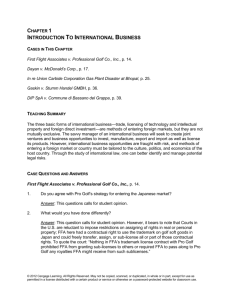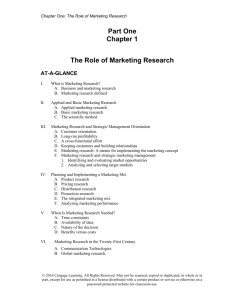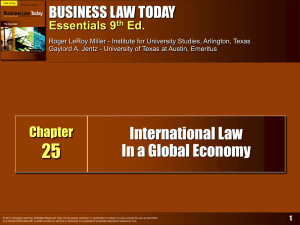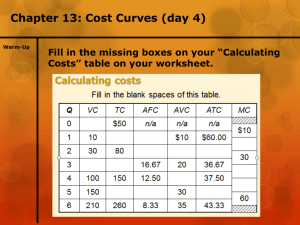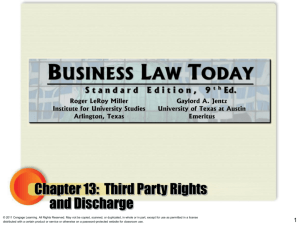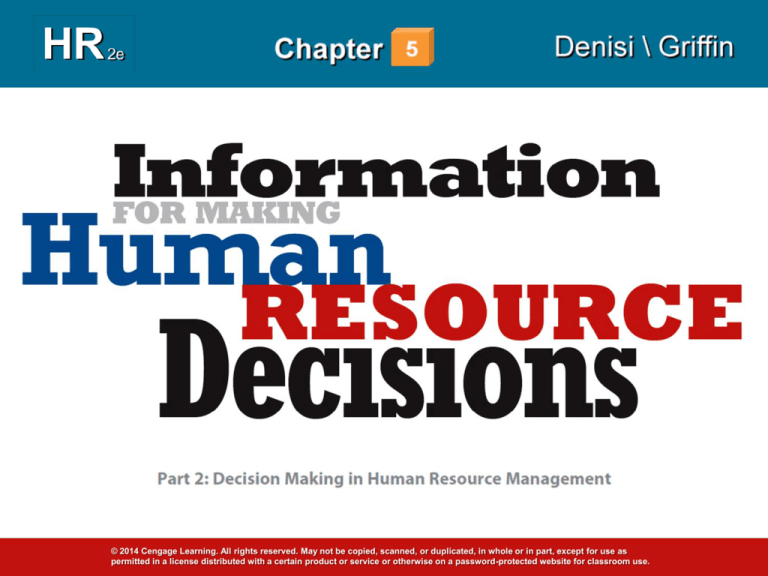
© 2014 Cengage Learning. All rights reserved. May not be copied, scanned, or duplicated, in whole or in part, except for use as
permitted in a license distributed with a certain product or service or otherwise on a password-protected website for classroom use.
Learning Objectives
After studying this chapter, you should be able to:
1. Describe human resource planning as a source of
information for decision making
2. Discuss strategy as a source of information for
making human resource decisions
3. Discuss economic conditions as a source of
information for making human resource decisions
4. Describe job analysis as a source of information for
making human resource decisions
5. Discuss the job-analysis process and identify and
summarize common job-analysis methods
© 2014 Cengage Learning. All rights reserved. May not be copied, scanned, or duplicated, in whole or in part, except for use as
permitted in a license distributed with a certain product or service or otherwise on a password-protected website for classroom use.
5–2
What Is Human Resource Planning?
The process of forecasting the
supply and demand for human
resources within an organization
and developing action plans for
aligning the two.
© 2014 Cengage Learning. All rights reserved. May not be copied, scanned, or duplicated, in whole or in part, except for use as
permitted in a license distributed with a certain product or service or otherwise on a password-protected website for classroom use.
5–3
The Human Resource Planning Process
© 2014 Cengage Learning. All rights reserved. May not be copied, scanned, or duplicated, in whole or in part, except for use as
permitted in a license distributed with a certain product or service or otherwise on a password-protected website for classroom use.
5–4
Beyond the Book:
Planning Human Resource Programs
© 2014 Cengage Learning. All rights reserved. May not be copied, scanned, or duplicated, in whole or in part, except for use as
permitted in a license distributed with a certain product or service or otherwise on a password-protected website for classroom use.
5–5
HR Information
Systems
• Human Resource Information System
An integrated and increasingly automated
system for maintaining a database regarding
the employees in an organization.
© 2014 Cengage Learning. All rights reserved. May not be copied, scanned, or duplicated, in whole or in part, except for use as
permitted in a license distributed with a certain product or service or otherwise on a password-protected website for classroom use.
5–6
• Labor Force Trends and Issues
Increasing workforce diversity
Gradual increase in average age of the
U. S. workforce
Entry of more women into the workforce
Changing ethnicities
Global economic conditions
© 2014 Cengage Learning. All rights reserved. May not be copied, scanned, or duplicated,
in whole or in part, except for use as permitted in a license distributed with a certain
product or service or otherwise on a password-protected website for classroom use.
5–7
United States Workforce
• The average age of the U.S. workforce is
gradually increasing because:
1.
The aging baby boom generation continues to work.
2.
Declining birthrates for the post–baby boom
generation mean a smaller percentage of new
entrants into the labor force.
3.
Improved health and medical care allow people to
be productive for longer periods of their lives.
4.
Mandatory retirement ages have been increased or
dropped altogether, allowing people to remain in the
labor force for longer periods.
© 2014 Cengage Learning. All rights reserved. May not be copied, scanned, or duplicated, in whole or in part, except for use as
permitted in a license distributed with a certain product or service or otherwise on a password-protected website for classroom use.
5–8
Executive Succession
• Systematically planning
for future promotions
into top management
positions
© 2014 Cengage Learning. All rights reserved. May not be copied, scanned, or duplicated, in whole or in part, except for use as
permitted in a license distributed with a certain product or service or otherwise on a password-protected website for classroom use.
5–9
Strategy as a Source
of Information
Implications of the
Chosen Strategy
Growth
strategy
Stability
strategy
Reduction
strategy
© 2014 Cengage Learning. All rights reserved. May not be copied, scanned, or duplicated, in whole or in part, except for use as
permitted in a license distributed with a certain product or service or otherwise on a password-protected website for classroom use.
5–10
Economic Conditions as
a Source of Information
Conditions in the
Economy
Rate of
unemployment
Market wage
rates
© 2014 Cengage Learning. All rights reserved. May not be copied, scanned, or duplicated, in whole or in part, except for use as
permitted in a license distributed with a certain product or service or otherwise on a password-protected website for classroom use.
5–11
Wages and Salaries Across the United
States (Hourly Basis)
Illinois
California
New York
Texas
Florida
© 2014 Cengage Learning. All rights reserved. May not be copied, scanned, or duplicated, in whole or in part, except for use as
permitted in a license distributed with a certain product or service or otherwise on a password-protected website for classroom use.
5–12
Strategy as a Source of Information
• Implications of a growth strategy:
Need to hire new employees
• Implications of a stability strategy:
Implement training to upgrade employee skills
Implement programs to help reduce turnover
• Implications of a reduction strategy:
Find ways to reduce workforce
Normal attrition processes
Retirement (including early retirement)
Layoffs
© 2014 Cengage Learning. All rights reserved. May not be copied, scanned, or duplicated, in whole or in part, except for use as
permitted in a license distributed with a certain product or service or otherwise on a password-protected website for classroom use.
5–13
Economic Conditions as
a Source of Information
• Rate of Unemployment
Is calculated by the Bureau of Labor Statistics
as the percentage of individuals looking for
and available for work who are not presently
employed.
• Market Wage Rate
Is the prevailing wage rate
for a given job in a given
labor market.
© 2014 Cengage Learning. All rights reserved. May not be copied, scanned, or duplicated, in whole or in part, except for use as
permitted in a license distributed with a certain product or service or otherwise on a password-protected website for classroom use.
5–14
Human Capital Investments
• Human Capital Investments
Are investments people makes in themselves
to increase their value in the workplace.
Can take the form of
additional education
or training.
© 2014 Cengage Learning. All rights reserved. May not be copied, scanned, or duplicated, in whole or in part, except for use as
permitted in a license distributed with a certain product or service or otherwise on a password-protected website for classroom use.
5–15
Job Analysis as a Source of Information
• Job Analysis
Is the process of gathering and organizing
detailed information about various jobs within
the organization so that managers can better
understand the process through which they
are performed most effectively.
© 2014 Cengage Learning. All rights reserved. May not be copied, scanned, or duplicated, in whole or in part, except for use as
permitted in a license distributed with a certain product or service or otherwise on a password-protected website for classroom use.
5–16
What Job Analysis Does?
• Job Analysis
Provides fundamental input to the HR
manager such as knowledge, skills, and
abilities (KSAs) which are the fundamental
requirements necessary to perform a job.
• Job Families
Are groups of jobs with similar task and
KSA requirements.
© 2014 Cengage Learning. All rights reserved. May not be copied, scanned, or duplicated, in whole or in part, except for use as
permitted in a license distributed with a certain product or service or otherwise on a password-protected website for classroom use.
5–17
The Job Analysis Process
• Job Analyst
Is the individual who performs job
analysis in an organization.
• Subject Matter Experts (SMEs):
Are individuals presumed to be highly
knowledgeable about a job and who
provides data for job analysis.
May be an existing job incumbent,
supervisor, or other knowledgeable
employee.
© 2014 Cengage Learning. All rights reserved. May not be copied, scanned, or duplicated, in whole or in part, except for use as
permitted in a license distributed with a certain product or service or otherwise on a password-protected website for classroom use.
5–18
Job Analysis and Other Human Resource Functions
© 2014 Cengage Learning. All rights reserved. May not be copied, scanned, or duplicated, in whole or in part, except for use as
permitted in a license distributed with a certain product or service or otherwise on a password-protected website for classroom use.
5–19
Occupational Information Network
• O*NET
A database of the KSAs required for jobs in
the U.S. economy.
• Standard Occupational Classification
Cognitive abilities
Psychometric abilities
Physical abilities
Sensory abilities
© 2014 Cengage Learning. All rights reserved. May not be copied, scanned, or duplicated, in whole or in part, except for use as
permitted in a license distributed with a certain product or service or otherwise on a password-protected website for classroom use.
5–20
Specific Job Analysis Techniques
Narrative Job
Analysis
Fleishman Job Analysis
System
Functional Job
Analysis
Job Analysis
Techniques
Position Analysis
Questionnaire
Management Position
Description Questionnaire
Task Analysis
Inventory
Critical Incidents
Approach
© 2014 Cengage Learning. All rights reserved. May not be copied, scanned, or duplicated, in whole or in part, except for use as
permitted in a license distributed with a certain product or service or otherwise on a password-protected website for classroom use.
5–21
Job Analysis Techniques
• Narrative Job Analysis
Has one or more SMEs prepare a written
narrative or text description of the job.
• The Fleishman Job-Analysis System
Defines abilities as enduring attributes of
individuals that account for differences in
performance.
Relies on a taxonomy of abilities that
presumably represents all of the dimensions
relevant to work.
© 2014 Cengage Learning. All rights reserved. May not be copied, scanned, or duplicated, in whole or in part, except for use as
permitted in a license distributed with a certain product or service or otherwise on a password-protected website for classroom use.
5–22
Job Analysis Techniques (cont’d)
• Task Analysis Inventory
Is a family of job analysis methods, each
with unique characteristics; each focuses
on analyzing all the tasks performed in
the focal job.
• Functional Job Analysis
Attempts to provide a single job analysis
instrument that can be used with a wide
variety of jobs.
© 2014 Cengage Learning. All rights reserved. May not be copied, scanned, or duplicated, in whole or in part, except for use as
permitted in a license distributed with a certain product or service or otherwise on a password-protected website for classroom use.
5–23
Job Analysis Techniques (cont’d)
• Position Analysis Questionnaire (PAQ)
Consists of 194 items reflecting work behavior,
working conditions, or job characteristics that
are assumed to be generalizable across jobs.
• Management Position Description
Questionnaire (MPDQ)
Contains 197 items that analyze how managerial
jobs are done in terms of 13 components
considered essential to all managerial jobs.
• Critical Incidents Approach
Focuses on critical behaviors that distinguish
between effective and ineffective performers.
© 2014 Cengage Learning. All rights reserved. May not be copied, scanned, or duplicated, in whole or in part, except for use as
permitted in a license distributed with a certain product or service or otherwise on a password-protected website for classroom use.
5–24
Steps in Job Analysis
© 2014 Cengage Learning. All rights reserved. May not be copied, scanned, or duplicated, in whole or in part, except for use as
permitted in a license distributed with a certain product or service or otherwise on a password-protected website for classroom use.
5–25
What Does a Job Description Do?
Lists the tasks, duties, and responsibilities
for a particular job. It specifies the major
job elements, provides examples of job
tasks, and provides some indication of
their relative importance in the effective
conduct of the job.
© 2014 Cengage Learning. All rights reserved. May not be copied, scanned, or duplicated, in whole or in part, except for use as
permitted in a license distributed with a certain product or service or otherwise on a password-protected website for classroom use.
5–26
What Does a Job Specification Do?
Focuses on the individual who will
perform the job and indicates the
knowledge, abilities, skills, and other
characteristics that an individual must
have to be able to perform the job.
© 2014 Cengage Learning. All rights reserved. May not be copied, scanned, or duplicated, in whole or in part, except for use as
permitted in a license distributed with a certain product or service or otherwise on a password-protected website for classroom use.
5–27
Example Job Description and Job Specification
© 2014 Cengage Learning. All rights reserved. May not be copied, scanned, or duplicated, in whole or in part, except for use as
permitted in a license distributed with a certain product or service or otherwise on a password-protected website for classroom use.
5–28
Modeling Competencies and
the End of the “Job”
• The traditional view of jobs and work is no
longer applicable.
People today work on teams that focus on getting
tasks accomplished rather than on specific task
requirements.
Employees often rotate tasks and responsibilities.
• There is a clear need for an alternative to
traditional job analysis.
© 2014 Cengage Learning. All rights reserved. May not be copied, scanned, or duplicated, in whole or in part, except for use as
permitted in a license distributed with a certain product or service or otherwise on a password-protected website for classroom use.
5–29
Legal Issues in Job Analysis
• Firms must provide clear and fair job
analyses in order to avoid legal
repercussions.
Albermarle v. Moody
ADA and ADAA
Gender discrimination
Autonomous work teams
and unions
© 2014 Cengage Learning. All rights reserved. May not be copied, scanned, or duplicated, in whole or in part, except for use as
permitted in a license distributed with a certain product or service or otherwise on a password-protected website for classroom use.
5–30




